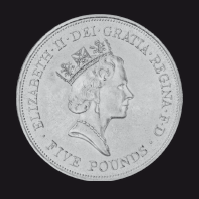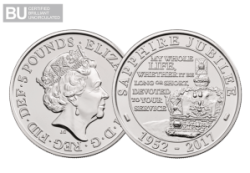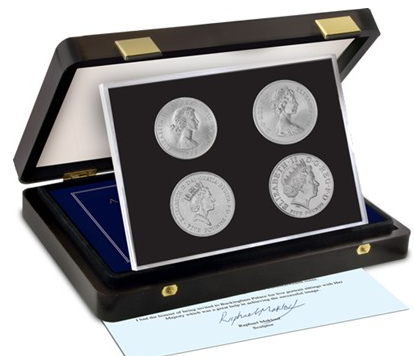Posts Tagged ‘Coronation Jubilee’
The six-sided Diamond Jubilee coin that never was…
Did you know that a special six-sided coin was very nearly released to commemorate one of the most significant celebrations in British history – the Queen’s Diamond Jubilee?
In fact, the coin was so close to being produced that the design was nearly sent off for Royal approval before the proposal was eventually rejected by senior staff at the Royal Mint.
But what could this coin have looked like? Stay tuned as we explore more in this blog…
What the UK’s first 60p could have looked like

A document from Kevin Clancy, secretary to the Royal Mint Advisory Committee, and addressed to the Master of the Mint at the time – Chancellor George Osborne, stated “The proposed coin would be a six-sided bi-colour coin with round of nickel-brass and a shaped outer of cupro-nickel.”
The document also stated: “It is recommended that an entirely new denomination coin – a 60p piece – should be produced to commemorate the 60 years of Her Majesty’s reign”.
Whilst the coin was proposed to be a commemorative-only issue and wouldn’t enter circulation, the idea for the coin was abandoned all together, as papers from the Royal Mint Advisory Committee revealed the commemorative coin programme was already ‘sufficiently comprehensive’.
This programme in question of course ended up bringing us the stunning 2012 Diamond Jubilee £5 Coin.
2012 Diamond Jubilee £5 Coin
This was the first coin ever to be struck to commemorate a Diamond Jubilee – there were no special coins for Queen Victoria’s in 1897!
The obverse featured a new portrait of Her Majesty crowned and wearing the robes of the Order of the Garter, created especially for the Diamond Jubilee by Ian Rank-Broadley.
Also designed by Ian Rank-Broadley, the obverse features a portrait of the young Queen Elizabeth just as she appeared in her first portrait with the Latin words DIRIGE DEUS GRESSUS MEOS (May God Guide My Steps).
If you don’t have this coin in your collection yet, Change Checker has strictly limited stock remaining. Secure yours here >>
This £5 isn’t the only remarkable issue we’ve seen commemorating Her Majesty’s Jubilees…
1993 Coronation 40th Anniversary £5
This £5 coin was issued to mark 40 years since the Queen’s coronation in 1953 – her Ruby Jubilee.
The obverse features the original portrait by Mary Gillick placed in a circle surrounded by eight mounted trumpeters of the Household Cavalry separated by swords and sceptres.
The reverse features the Crown of St Edward which was used at the Coronation, set within 40 radiating trumpets.
The words FAITH AND TRUTH I WILL BEAR UNTO YOU, from the Coronation oath, are inscribed at the top, with the double dates 1953 and 1993 appearing at the foot.
Change Checker has limited stock remaining of this coin. Secure one for your collection here >>
2002 Golden Jubilee £5

In 2002, to mark the 50th anniversary of the Queen’s accession to the throne, the Royal Mint produced this £5 coin.
On one side appears an unusual bust portrait of the Queen wearing the robes of state. The dramatic impact of this motif are heightened by the absence of any inscription other than the value in small lettering around the foot.
The reverse design, as with the original Coronation crown of 1953 features the Queen on horseback. The Latin motto AMOR POPULI PRAESIDIUM REG(inae) meaning ‘The love of the people is the Queen’s protection’ was last used on the coinage of Charles I.
You can add this coin to your collection here >>
The Queen’s Platinum Jubilee in 2022

In 2022, Her Majesty will celebrate her Platinum Jubilee, after a magnificent 70 years of service to the throne.
According to the Government website, plans are already in place to mark this anniversary, including collaborations with “some of the UK’s leading creative minds, event organisers and world class digital design companies”.
In keeping with tradition, a Platinum Jubilee medal is said to be awarded to people “who work in public service including representatives of the Armed Forces, the emergency services and the prison services.
This tradition stretches back to the reign of Queen Victoria when an official medal was designed to mark her 50th anniversary on the throne”.
Whilst there has been no official confirmation of a Platinum Jubilee commemorative coin in the works, we’re certainly going to keep our fingers crossed that this magnificent anniversary will be celebrated on our UK coinage.
Would you have liked to have seen a six-sided 60p issued to commemorate Her Majesty’s Jubilee anniversary? Let us know in the comments!
Receive new UK coins without the hassle of placing orders on the day of release!
Join the Change Checker UK CERTIFIED BU Subscription Service and receive new UK coins sent to your door without the hassle of placing orders on the day of release!
Don’t miss your chance to get ahead of the crowd and be one of the very first collectors to receive the latest UK new issue coins as soon as possible after their release.
The Sapphire Jubilee – a first in British Royal history
This year Her Majesty Queen Elizabeth II will celebrate her Sapphire Jubilee – the first ever British monarch in history to do so.
It is the first Sapphire Jubilee to be celebrated in British Royal history and as you can imagine this is a significant event for collectors and an occasion that deserves celebration.
The Royal Mint have issued a brand new £5 coin to mark the occasion, so I thought I’d take a look back at the history and timeless designs of previous UK jubilee coins issued during Her Majesty’s reign…
Own the brand new Sapphire Jubilee £5
Click here to own the brand new UK £5 coin issued by The Royal Mint to celebrate Her Majesty’s Sapphire Jubilee – the first British monarch in history to do so.
Portraits of a Queen – the changing face of Britain’s coinage
Discover a little of the history behind the Queen’s effigy and vote for your favourite portrait.
As well as the 60th Coronation Anniversary, 2013 marks the 60th Anniversary of the Queen’s coinage.
The first Queen Elizabeth II coins were struck in 1953 and since then four different effigies adorned our coins.

1953 – 1967: Mary Gillick
The first coins of Queen Elizabeth’s reign bore Mary Gillick’s portrait of the young Queen, engraved especially for the new coins.
Her uncrowned portrait of the Queen is still used on the Maundy Money distributed each year by Her Majesty.
With the upcoming decimilisation, it was decided to refresh the Queen’s portrait with Arnold Machin’s new sculpture of the Queen. Commissioned in 1964, it first appeared in 1968 on the new 5p and 10p coins. A version of the design with tiara was also introduced on stamps in 1967 and remains to this day.

1985 – 1997: Raphael Maklouf
In creating his new effigy of Her Majesty, Raphael Maklouf aimed “to create a symbol, regal and ageless”.
His “couped” portrait depicts Queen Elizabeth II wearing the royal diadem favoured by her on the way to and from the State Opening of Parliament.
 1998 – current: Ian Rank-Broadley FRBS
1998 – current: Ian Rank-Broadley FRBS
The current Queen’s head on our coinage was designed in 1997 by Ian Rank-Broadley. Created to fill the full circle of the coin, its larger size was a deliberate response to the smaller 5p and 10p coins in circulation. A noticeably more mature portrayal of Her Majesty, Rank-Broadley aimed to show the Queen with “poise and bearing”.
You can own all four Portraits on original UK Crowns.
Click here for more info about the Portraits of the Queen 4-coin set







